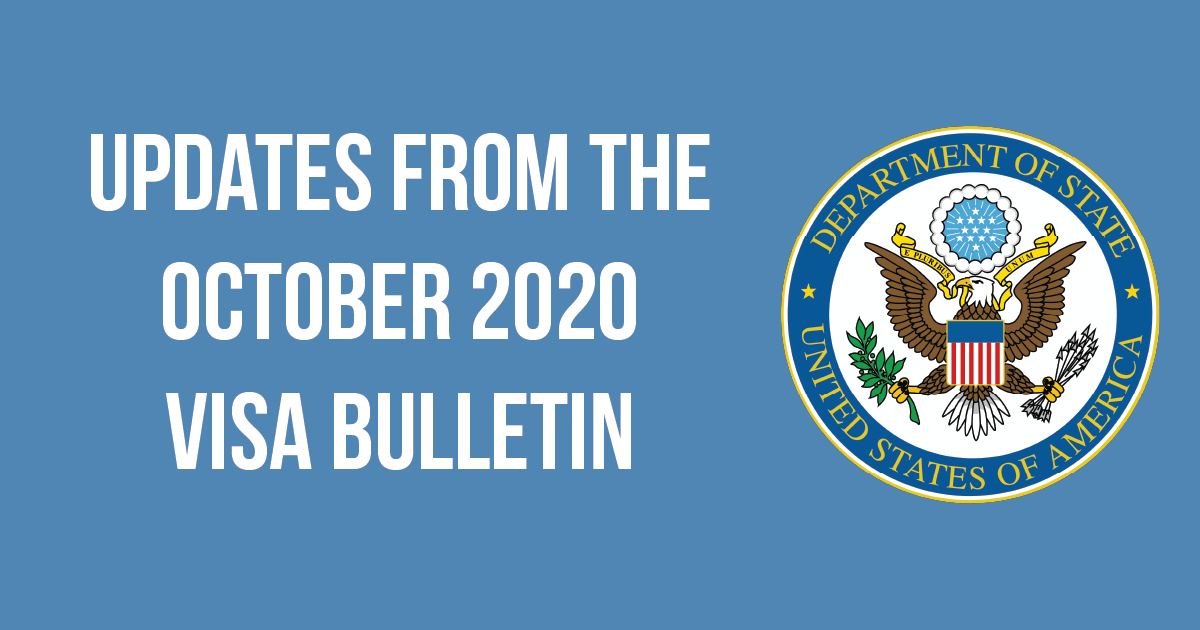
There are limits on the number of foreign nationals who can complete the U.S. permanent resident process each year. Due to these limits, a backlog (or line) of people who are waiting to finish the permanent resident process has developed. Each month, the U.S. Department of State releases the Visa Bulletin to announce any movement in these backlogs or to announce that a category has no backlog and is “current.”
In order to complete the permanent resident process, a foreign national must have a visa available to people from their country of birth, in their immigration category. Each year, the new visas become available at the beginning of the fiscal year, which runs from October 1 to September 30. This means that we typically see the most movement in the backlogs in October, when the new visas become available.
The year 2020 has been very unique and the 2020 Visa Bulletin reflects the unique circumstances of the year. Due to the COVID-19 pandemic, the U.S. Embassies/Consulates throughout the world have been mostly closed for routine visa services. Without the Embassies/Consulates processing immigrant visa applications, many available visas from 2020 have not been used. This means that the unused visas have been added to the visas that are available for use in Fiscal Year (FY) 2021, which began on October 1, 2020.
The availability of more visas in FY 2021 has allowed the U.S. Department of State to advance the dates on the Visa Bulletin at a rapid pace for October 2020, especially in the employment-based categories. Of particular importance in the October 2020 Visa Bulletin is the fact that there has been rapid advancement in the “Table B, Dates for Filing Chart” for foreign nationals from India and China.
Each month, two charts are released in the Visa Bulletin: 1) Table A, Final Action Date Chart and 2) Table B, Dates for Filing Chart. Table A indicates the date that a visa is available for a foreign national to complete the permanent resident process (meaning they can get their green card), while Table B indicates the date that a person can begin the immigrant visa application process through a U.S. Embassy/Consulate abroad or file their Adjustment of Status (AOS) application with U.S. Citizenship & Immigration Services (USCIS) in the United States. Each month, USCIS decides whether it will accept AOS applications based on Table A or Table B. Generally, USCIS has accepted AOS applications filed based on Table B in the first few months of the fiscal year and has stopped accepting AOS applications based on Table B and only accepts them based on Table A in the later months of the fiscal year.
EB-2 Downgrade to EB-3
For October 2020, USCIS announced that it will accept the Table B, Dates for Filing Chart. This is important for foreign nationals from India and China who may have a priority date that is now “current,” meaning that, if they are in the United States, they are now able to proceed with filing an AOS application with USCIS.
Many foreign nationals from India or China may also be able to take advantage of the ability to move between employment-based permanent resident categories to use the category that has the best priority date. If a foreign national has a priority date based on an EB-2 Immigrant Petition, but the EB-3 priority date will now allow them to file an AOS application, an EB-2 downgrade may be a useful tool.
If the foreign national works for the same employer who filed their PERM Labor Certification and their I-140 Immigrant Petition, the employer is able to file a new I-140 Immigrant Petition requesting for USCIS to “downgrade” the category from EB-2 to EB-3. If the foreign national’s priority date is current for EB-3 on Table B, the foreign national can also submit the AOS concurrently with the new I-140 Immigrant Petition. If the new I-140 Immigrant Petition is approved, the foreign national will be able to maintain the pending AOS until the time when their priority date is finally current on Table A and they are able to finish the permanent resident process.
Filing the AOS has many benefits, including providing the foreign national with the ability to “port” or transfer their permanent resident process to a new employer after the AOS has been pending for 180 days. Additionally, through the pending AOS, the foreign national can obtain an Employment Authorization Document (EAD) and Advance Parole (AP) travel permit, allowing the foreign national to work and travel abroad while the permanent resident process is pending.
Though EB-2 has historically been considered the faster category to use, so many people have now used EB-2 that the EB-3 priority dates are better than EB-2. But this change in the visa bulletin will certainly cause many applicants to file EB-2 downgrade petitions, which will likely flood the EB-3 category again and may cause the dates to retrogress again.
Luckily, filing the EB-2 downgrade petition does not automatically invalidate the prior EB-2 petition, so in the event that the EB-2 downgrade is not successful or if the EB-3 category becomes more backlogged than the EB-2 category, as a general matter, the EB-2 petition remains unaffected.
Time is of the essence. No one can guarantee how long the priority dates will remain this way before they retrogress due to so many people filing AOS applications at the same time. It is best to file any application as soon as possible to ensure that the foreign national does not lose the ability to file an AOS application.
It is critical to properly file the EB-2 downgrade petition so that the foreign national preserves the ability to use the originally approved I-140, if necessary, in the future. Therefore, it is highly recommended that foreign nationals and their employers work with a skilled business immigration attorney on this process.
In case you think that you might qualify for downgrading your EB-2 petition to EB-3 petition or want to learn more about how this downgrade process works, please contact us today.

